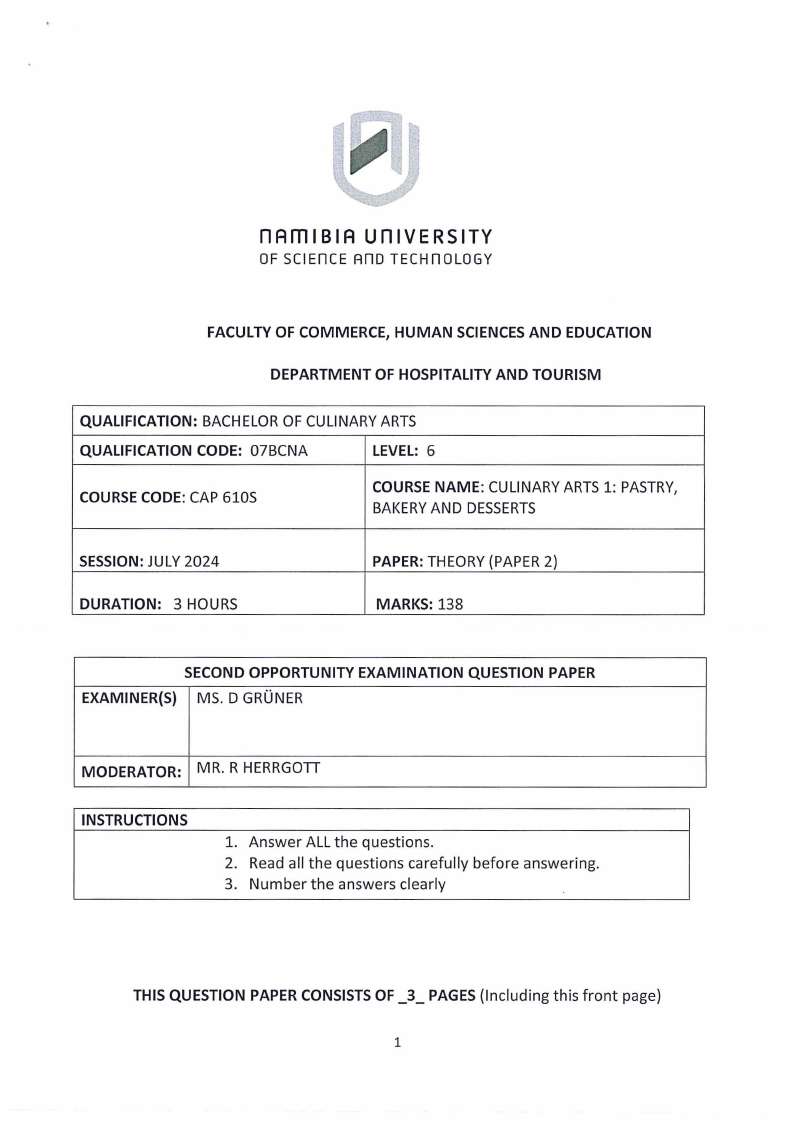 |
CAP610S - CULINARY ARTS 1 PASTRY BAKERY AND DESSERTS - 2ND OPP - JULY 2024 |
 |
1 Page 1 |
▲back to top |

nAmlBIA unlVERSITY
OF SCI En CE
TECH n 0 LOGY
FACULTY OF COMMERCE, HUMAN SCIENCES AND EDUCATION
DEPARTMENT OF HOSPITALITY AND TOURISM
QUALIFICATION: BACHELOR OF CULINARY ARTS
QUALIFICATION CODE: 07BCNA
LEVEL: 6
COURSE CODE: CAP 6105
COURSE NAME: CULINARY ARTS 1: PASTRY,
BAKERY AND DESSERTS
SESSION: JULY 2024
DURATION: 3 HOURS
PAPER: THEORY (PAPER 2)
MARKS: 138
SECOND OPPORTUNITY EXAMINATION QUESTION PAPER
EXAMINER(S) MS. D GRUNER
MODERATOR: MR. R HERRGOTT
INSTRUCTIONS
1. Answer ALL the questions.
2. Read all the questions carefully before answering.
3. Number the answers clearly
THIS QUESTION PAPER CONSISTS OF _3_ PAGES (Including this front page)
1
 |
2 Page 2 |
▲back to top |

Question 1: (Historical background)
6 Marks
Describe the first grain foods in history and how they lead to the first leavened ancient bread?
Question 2: (Formulas/ Bakeshop Math)
10 Marks
What type of information would you find in standardized formulas or recipes? Name 5 of them and
explain in brief.
Question 3: (Ingredients)
9 Marks
What are the main components of wheat flour? Name the main components with their respective
nutrient groups.
Question 4: (Ingredients)
What are the six functions of sugar in baked goods?
6 Marks
Question 5: (Ingredients)
8 Marks
What are the advantages and disadvantages of using butter in baked goods? Name two of each and
explain them.
Question 6: (Equipment)
10 Marks
List and describe 5 small, specialized equipment used in the bake shop and pastry department and
explain in brief what they do.
Question 7: (Basic Baking principles)
8 Marks
Describe the following terms in detail and explain what role it plays in the formation of the dough/
baked
good?
7.1 Oxidation (4)
7.2 Leavening (4)
Question 8: (Lean Yeast doughs)
12 Marks
Three basic mixing techniques are used for most yeast products. Name and explain the purpose of
mixing and the 3 basic mixing methods in brief and explain the different effects they have on
fermentation time as well as the final structure of the bread and or yeast product.
Question 9: (Sponges and Pre -ferments)
6 Marks
What are the advantages of using a sponge or yeast pre-ferment to make bread doughs? Name 3
advantages and explain them in brief.
Question 10: (Rich yeast doughs)
8 Marks
What is the rolling-in procedure for laminated yeast doughs? Describe how to make a laminated
dough such as Croissants or Danish Pastry.
2
 |
3 Page 3 |
▲back to top |

r
Question 11: (Quick Breads)
8 Marks
What is the difference between the biscuit method and the muffin method when making quick
breads? Explain in brief.
Question 12: (Basic Syrups, Creams, and sauces)
10 Marks
What is pastry cream, and how is it made? Explain step by step how pastry cream is made.
Question 13: (Pies)
Describe step by step on how to make a pie dough.
6 Marks
Question 14: (Pastry Basics)
Describe in easy-to-follow steps on how to make choux paste/eclair pastry?
8 Marks
Question 15: (Cake Mixing and Baking)
Outline the procedure of making a cake with the creaming (conventional) method.
8 Marks
Question 16: (Custards, Puddings and Mousses)
What is a Panna cotta and how is it made? Explain
6 Marks
Question 17: (Frozen Desserts)
9 Marks
What is the difference between ice cream, sorbet, and still frozen ice cream (parfait)? Explain in
detail.
••••••••••••••••••••••••••••••••••••••••••••••••••••••••••••••••••••••••••••••••••
TOTAL
138 Marks
3





